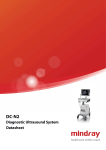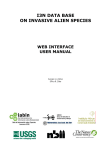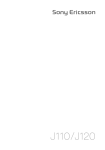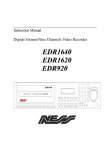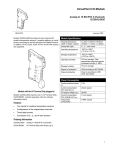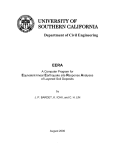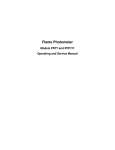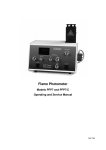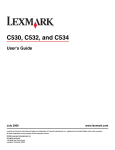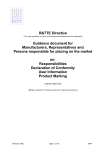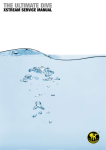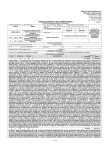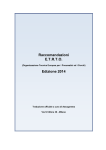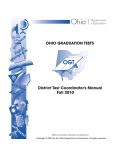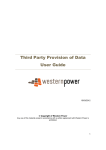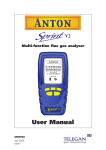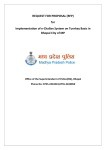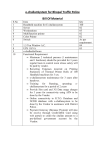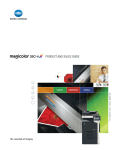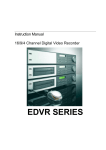Download Industry Voluntary Agreement to improve the
Transcript
INDUSTRY VOLUNTARY AGREEMENT TO IMPROVE THE ENVIRONMENTAL PERFORMANCE OF IMAGING EQUIPMENT PLACED ON THE EUROPEAN MARKET VA v.4 – 3 December 2012 (Including style changes based on agreed VA v.3.5 – 15 February 2011) EXPLANATORY NOTES TO THIS DRAFT DOCUMENT The intention of this revision is solely to correct language imperfections (such as the use of UK English spelling), clarify certain sections, and correct inconsistencies. Essential parts of the Agreement such as e.g. obligations and commitments of the Signatories, tasks of the Independent Inspector and Steering Committee have not been modified in anyway. INDUSTRY VOLUNTARY AGREEMENT - IMAGING EQUIPMENT version 4 1 Contents 1 Introduction.......................................................................................................................... 3 2 Objectives............................................................................................................................ 4 3 Scope .................................................................................................................................. 4 4 Commitments Part I – Design Requirements ...................................................................... 5 5 Commitments Part II – Information Requirements .............................................................. 7 6 Reporting and monitoring .................................................................................................... 8 7 Nature and Organization of the Voluntary Agreement ........................................................ 9 8 Voting Rules ...................................................................................................................... 10 9 Non Compliance ................................................................................................................ 10 10 Verification ....................................................................................................................... 10 11 Revision of the Voluntary Agreement .............................................................................. 11 12 Termination of the Voluntary Agreement......................................................................... 11 Annex A: Definitions ................................................................................................................ 12 Annex C: Reporting form to be used to report to Independent Inspector ................................ 16 Annex D: Signing Form ........................................................................................................... 18 Annex E: Example of Product Environmental Information ....................................................... 19 INDUSTRY VOLUNTARY AGREEMENT - IMAGING EQUIPMENT version 4 2 1 Introduction The imaging industry is an innovative industry with a long track record on environmental improvements. The imaging industry wishes to formalize their commitment to continuous improvement via this voluntary agreement (“Voluntary Agreement”) which we believe will help to contribute to the achievement of the EU Action Plan on Energy Efficiency. It is expected that the proposed Commitments as defined herein will enable energy savings of around 1 to 1,5 TWh per year in EU27 excluding the additional savings that will be made through increased resource efficiency. This Voluntary Agreement should enable customers to make more sustainable purchasing decisions by providing them more accurate information on the environmental performance of our products. The imaging industry has been working on this Voluntary Agreement since spring 2009 and has been open for 1 participation from all producers. The current market coverage of the companies involved in the drafting process is over 95% based on units sold in the EU. The goal is to continue to expand the coverage of the voluntary agreement and to include as many companies as possible. The scope of the voluntary agreement is based on the ErP Preparatory Study and linked with ENERGY STAR®. It aims to target the highest sales volume products and technologies on the household and office market. Technologies of declining markets such as small photo and scanner devices have been excluded from the scope of the agreement to ensure that companies can focus resources on improving the performance of our products in the high volume, high growth markets/sectors. It became clear from the ErP Preparatory Studies on “Imaging Equipment” (Lot 4), that the product category Imaging Equipment contains a wide variety of product types, designed and marketed for a wide variety of markets and applications. Products range from a very affordable personal printer that is used occasionally by a private household user, through multifunctional devices used in offices to accommodate the daily needs for copying, printing, scanning and faxing of documents for groups of office workers, up to highly productive printing systems that are designed to run continuously in print rooms. For such widely different applications, widely different imaging technologies have been developed since instant printing emerged in the market in the 1920’s: inkjet printing and electrophotographic printing are the most well-known of the core technologies used in the printers to transfer information onto paper. In addition to the core technologies, a wide range of additional convenient functionalities have been added to imaging equipment: ranging from modules for automated duplex printing to modules for stapling, punching and even digital document storage inside the printer’s memory. Each technology and each additional function has its own environmental impact. It should be noted that the implementations of the core technologies and additional functions is very different between the different producers in the imaging industry. When setting out to develop the underlying Voluntary Agreement, the imaging industry was faced with the challenge to formulate requirements that are not only relevant and significant for achieving environmental efficiency, but also applicable to the wide range of different imaging products present in the market. Despite the fact that the imaging industry focused on the products that are sold in the highest numbers, by limiting the product scope to household and office equipment, the problem of diversity still remained, which is mainly driven by the wide variety of customer requirements in the imaging market. For the reasons outlined above, the imaging industry will commit to the requirements in this Voluntary Agreement for the vast majority of its products. Nevertheless the allowance of exemptions could not be avoided. In line with the European Commission’s “Communication on Environmental Agreements at Community level 2 within the Framework of the Action Plan on the Simplification and Improvement of the Regulatory Environment” , this Voluntary Agreement is to be acknowledged by the European Commission through a Report to the European Parliament and the Council, once the relevant process has been completed. The Signatories of this Voluntary Agreement are: 1. Brother International Europe 1 Please note that at the time of this style changes revision the number of Signatories of the VA is 16 and the market coverage around 95%. The Eastman Kodak Company (Kodak), decided to withdraw from the VA for Imaging Equipment in October 2012 due to a straightforward business decision. According to recent corporate announcements, Kodak will no longer market in the EU imaging equipment, within the current VA scope. 2 http://eur-lex.europa.eu/LexUriServ/LexUriServ.do?uri=CELEX:52002DC0412:EN:NOT INDUSTRY VOLUNTARY AGREEMENT - IMAGING EQUIPMENT version 4 3 2. 3. 4. 5. 6. 7. 8. 9. 10. 11. 12. 13. 14. 15. 16. Canon Dell Epson HP Konica Minolta Business Solutions Europe GmbH Kyocera Mita Lexmark International nv/sa Murata Machinery Europe GmbH OKI (UK) Ltd. Panasonic Europe Ltd. Ricoh Europe PLC Samsung Electronics Europe Sharp Electronics (Europe) GmbH Toshiba TEC Germany Imaging Systems GmbH Xerox 2 Objectives 2.1 Continuously improve the environmental performance of the types of imaging equipment in scope of this agreement. 2.2 Contribute to the objectives of Directive 2009/125/EC establishing a framework for the setting of ecodesign requirements for energy-related products, in line with Recitals 18-21 Article 17 and Annex VIII on self-regulation measures. 2.3 Ensure the involvement of all stakeholders represented in the Consultation Forum in monitoring of the results and updating the requirements of the Voluntary Agreement. 3 Scope 3.1 General: All terms used in this section are defined in Annex C, Part VII to the Agreement between the Government of the United States and the European Community on the coordination of energy-efficiency labelling programmes for office equipment, as set out in the Annex to the Commission Decision 3 2009/347/EC on ENERGY STAR ® . 3.2 For the purposes of this Voluntary Agreement, “products” are understood as imaging equipment meeting the conditions in section 3.3. The terms “imaging equipment” and “product” do not include cartridges or other consumables. 3.3 Scope: 3.3.1 Product categories: The Voluntary Agreement covers imaging equipment belonging to one of the following product categories that have been reviewed in the ErP Lot 4 preparatory study: • • • Copiers Multifunction Devices (MFDs) Printers The EU ENERGY STAR ® program follows an Agreement between the Government of the US and the European Community (EU) to coordinate energy labelling of office equipment. It is managed by the European Commission. US partner is the Environmental Protection Agency (EPA) that started the scheme in the US in 1992 (European Council decision PDF (97kb). 3 INDUSTRY VOLUNTARY AGREEMENT - IMAGING EQUIPMENT version 4 4 • Fax machines. 3.3.2 Cartridges: This refers to cartridges produced by or recommended by the OEM for use in the products set out in 3.3.1. 3.3.3 Marking technologies: This Agreement is limited to the following marking technologies: • • • Electrophotography (EP) Inkjet (IJ), including high performance IJ Solid Ink (SI). 3.3.4 Household and office equipment: This Voluntary Agreement is limited to household and office equipment, meaning: • Standard black & white (BW) format products with maximum speed < 66 A4 images per minute • Standard Colour format products with maximum speed <51 A4 images per minute (Speed to be rounded to the nearest integer as prescribed in the ENERGY STAR ® agreement). Other format products can be included in their reporting by individual Signatories on a voluntary basis but will not count for the target specified in 4.1 a). 4 Commitments Part I – Design Requirements Signatories commit to: 4.1 Compliance on primary requirements a) Products as defined in section 3 and placed on the EU market by Signatories shall comply with the specifications of ENERGY STAR v1.1 and duplex settings requirements in accordance with the following target: • By 1 January 2012: 90% or more of the products placed by a Signatory on the market. For the purposes of compliance with section (a), the rate of compliance shall be calculated following the methodology described in Annex B. b) The specifications in ENERGY STAR v1.1 and duplex settings concern: 1. 2. 3. 4. Energy consumption requirements (TEC and OM products); Default delay times (OM products); and Duplex availability (TEC products). Duplex-printing is set as default when printing from the computer, meaning that the relevant software (driver or firmware) shall be configured so that the first print-job will be in duplex unless the print settings have been modified at the stage when the product is first installed to function as intended. INDUSTRY VOLUNTARY AGREEMENT - IMAGING EQUIPMENT version 4 5 5. Summary of Duplex requirements for TEC approach products Monochrome Print Speed Colour products <=19ppm Monochrome products <=24ppm No requirement Automatic duplexing must be offered as a standard feature or optional 25-‐44ppm accessory at the time of purchase. Automatic duplexing is required as a standard feature at the time of >=45ppm purchase. 20-‐39ppm >=40ppm 4.2 Duplex Requirements as per Energy Star V 1.1 Default Duplex set at shipment or at installation Not applicable At discretion of either the user or manufacturer Required Availability of N-up printing All printing products placed on the market after 1 January 2012 offer as a standard feature the capability to print several pages of a document on one sheet of paper, when the product is managed by an original software provided by the manufacturer (printer driver). 4.3 Design for recycling 4 For all new product models introduced after 1 January 2012: 4.3.1 Plastic parts >100 g shall be manually separable into recyclable plastic streams with commonly available tools. 4.3.2 Product shall utilize commonly used fasteners for joining components, subassemblies, chassis and enclosures. 4.3.3 Non-separable connections (e.g. glued, welded) between different materials shall be avoided unless they are technically or legally required. 4.3.4 Product plastics shall be marked by material type (ISO 11469 referring ISO 1043, resin identification code, SPI, DIN, or country specific). Marking requirement does not apply to plastic parts weighing less than 25 g or with surface area less than 50 cm²; tape; plastic protective and stretch wraps and labels; or plastic pieces when due to shape marking is not possible. Exempted are plastic parts contained in reused complex modules. 4.4 Cartridges 5 For all products placed on the market after 1 January 2012: 4.4.1 Any cartridge produced by or recommended by the OEM for use in the product shall not be designed to prevent its reuse and recycling. 4.4.2 The machine shall not be designed to prevent the use of a non-OEM cartridge. The requirements of paragraph 4.4 shall not be interpreted in such a way that would prevent or limit innovation, development or improvements in design or functionality of the products, cartridges, etc. An exemption from the criteria in section 4.2 and 4.3 will be acceptable for models that are sold in small numbers (less than 5000 per year), on the ground that the cost of implementing the criteria is disproportionate to 4 Following commitments are drawn from section 4.3.1 Disassemble-ability of the IEEE 1680.2 Draft Standard for Environmental Assessment of Imaging Equipment (EPEAT criteria) 5 Following commitments are drawn from section 4.9.4. “Not inhibiting reuse of cartridges” and 4.9.2 4. “Allow use of Non-OEM Cartridges” of the IEEE 1680.2 Draft Standard for Environmental Assessment of Imaging Equipment (EPEAT criteria) INDUSTRY VOLUNTARY AGREEMENT - IMAGING EQUIPMENT version 4 6 the sales of the product. Exceptions should be reported to the Independent Inspector (see Annex C, section 4 for reporting template). 5 Commitments Part II – Information Requirements Signatories commit to: 5.1 Environmental information for end-users in relation to use and end-of-life 5.1.1 Resource- and energy-efficiency For new models introduced after 1 January 2012, Signatories commit to providing end-users with information regarding resource efficiency when using imaging equipment. The intent is to ensure the enduser is made aware of good efficiency practices when they first begin to use a new product. Signatories shall achieve this through one of the following methods: 6 • A pop-up screen on the end-users’ computer during the initial installation of software (preferred) • An insertion sheet provided in/on the box of the product as defined in Section 3 above • An information sheet to be provided at the time of sale of the product as defined in Section 3 above 7 The following information shall be provided as a minimum where applicable: 5.1.1.1 Information that recycled as well as virgin paper certified under environmental stewardship initiatives, or carrying recognised ecolabels, may be suitable providing that it meets appropriate quality standards as defined, for example, in EN 12281 on “Printing and business paper for dry toner imaging processes” for papers in the range 75-250 g/m2. For specific applications, the lower boundary may be chosen at 64 g/m2. 5.1.1.2 For Electro Photography printers: indication that these can print on 64 gr/m2 paper and that this paper contains less raw material per print, thus saving significant resources. 5.1.1.3 Energy can be saved by purchasing ENERGY STAR ® compliant products. 5.1.1.4 Description of the benefits of printing in duplex mode (for TEC products having a duplex function). 5.1.1.5 The environmental benefits of power management. The information as described in sections 5.1.1.1 through 5.1.1.5 shall be provided in the form of compact statements. Paragraph 5.1.1 applies to: all new product models introduced after 1 January 2012. Paper weight mentioned in the pop-up window (or alternatives as described above) shall be consistent with the paper weight specifications of the product. 5.1.2 Cartridge disposal and treatment For products placed on the market after 1 January 2012, Signatories shall provide end-users with information on suitable end-of-life management options for used cartridges. This information may be communicated via a company website. 6 This can only be implemented when imaging equipments are managed through computers under mainstream Operating Systems (Microsoft Windows or Mac/OS) 7 Not all 5 statements mentioned in section 5.1.1 may be applicable to the product that is equipped with this information. Manufacturers are free to choose if they add a statement to this effect to the information, or leave out statements that are not applicable, such as the statement regarding electrophotography and duplex printing. INDUSTRY VOLUNTARY AGREEMENT - IMAGING EQUIPMENT version 4 7 5.2 Information on product environmental characteristics to be provided by Signatories The following applies to products placed on the market after 1 January 2012. 5.2.1 Signatories shall make information on the environmental performance of their products available to 8, customers. This information may take the form of for example ECMA 370, The Eco Declaration 9 EPEAT verification documentation , or similar company formats. 5.2.2 Signatories shall make information on inkjet and toner cartridge yield available to customers based on the measurement standards specified, for example, in ISO/IEC 24711:2006 (for ink), ISO/IEC 19752:2004 (for monochrome toner), ISO/IEC 19798:2006 (for colour toner), or through other company methods. An exemption from the criteria in section 5.1 and 5.2 will be acceptable for models that are sold in small numbers (less than 5000 per year), on the ground that the cost of implementing the criteria is disproportionate to the sales of the product. Exceptions should be reported to the Independent Inspector (see Annex C, section 4 for reporting template). 6 Reporting and monitoring 6.1 Signatories shall submit to an Independent Inspector reports based on compliance with the Voluntary Agreement (the “Reports”) according to the guidelines in this Section. 6.2 The reports shall include: • • • • Company name Compliance status (compliant/non-compliant) + sales data per model (to allow for verification) Rate of compliance with the commitments listed in section 4.1 Compliance confirmation for all other commitments. Annex C shows the template according to which the Reports shall be prepared by the Signatories. Compliance to all Commitments has to be reported according to the following schedule: - A first Report by 1 October 2011 shall cover products placed on the market and Signatory commitments between 1 January 2011 and 30 June 2011. This Report will establish the initial baseline for the Voluntary Agreement. - A second Report by 1 July 2012 shall cover products placed on the market between 1 October 2011 and 31 March 2012 and demonstrate compliance with targets set for 1January, 2012. - Unless differently stated in forthcoming revisions of the current Voluntary Agreement, the following reports shall be established by 31 March every year covering products placed on the market during the previous full calendar year, e.g. by 31 March 2013 for products placed on the market between 1 January 2012 and 31 December 2012. Within two weeks following the end of a reporting period, the Independent Inspector shall send a request to the Signatories to file their Reports. These shall be submitted no later than three months after the end of the reporting period to the Independent Inspector. 8 The eco declaration (ECMA 370) is a communication tool for customers. ECMA 370 declaration was developed to answer questions from customers to choose the best supplier. The standard addresses individual company programs and product related attributes. 9 EPEAT, the Electronic Product Environmental Assessment Tool, is a set of environmental criteria to support green public procurement and environmentally conscious purchasing decisions. For Imaging Equipment, an EPEAT standard is being developed (IEEE1680.2) that will include a specification of the verification documentation that the manufacturer has to make available in order to have a product registered with EPEAT. This documentation will provide disclosure of environmental performance. INDUSTRY VOLUNTARY AGREEMENT - IMAGING EQUIPMENT version 4 8 The Reports shall be compiled by the Independent Inspector into an annual progress report (the “Annual Progress Report”) that will be submitted to the Steering Committee within 4 months following the end of a period. This Annual Progress Report will be prepared by the Independent Inspector and will only show anonymous results. Signatories will not be named although individual achievements shall be disclosed (company A, company B, etc). The Independent Inspector shall be responsible for ensuring that confidentiality of the Signatory’s identity and any data or information provided to it under or in relation to this agreement is maintained this shall include entering into a non-disclosure agreement with each Signatory if requested by the Signatory. 6.3 The Steering Committee shall meet at least twice a year to discuss the Annual Progress Report and shall decide if an independent audit is required to verify the accuracy of "Annual Progress Report" or of an individual signatory. The results of the independent audit shall be submitted to the Steering Committee. Any independent auditor will be required to treat the identity and data of the Signatories as confidential and shall if requested by any Signatory enter into a non-disclosure agreement with each Signatory before having access to the data. 7 Nature and Organization of the Voluntary Agreement 7.1 Nature of the Voluntary Agreement The Signatory signs and enters into this Agreement for and on behalf of itself and makes its commitment under the Voluntary Agreement to the European Commission. The consequences of non-compliance are set out in section 9. This Agreement shall not amount to a commercial agreement and shall not give rise to any commercial expectations or liabilities between the Signatories in respect of the fulfillment of their individual Commitments as listed in this Voluntary Agreement. All Signatories shall be treated equally and there shall be no special arrangements for individual Signatories. 7.2 Organisation of the Voluntary Agreement Each Signatory to the Voluntary Agreement as well as the European Commission shall have the right to nominate one person to represent it at the Steering Committee. The Steering Committee shall elect, from amongst its members, a Chair. The Chair shall be responsible for convening the Steering Committee at least twice a year, in order inter alia to review progress and analyse and discuss reports presented by the Independent Inspector. The Chair shall, however, have no executive or representative function unless this is delegated to them by the Steering Committee. Meetings of the Steering Committee shall be open to • Any person representing a Signatory or potential signatory to this Agreement; • Any representatives of the European Commission or Member States, as well as Member States of the EEA or EFTA; and • Organisations that have a permanent seat on the Consultation Forum. The Steering Committee will seek to achieve agreement by consensus at all times. If consensus cannot be achieved, the Steering Committee may reach a decision in accordance with the voting procedures described in Section 8 of this Voluntary Agreement. The Steering Committee may decide to develop and adopt further rules of procedure where it deems it necessary and may decide to delegate powers where it deems it to be necessary to specific individuals or to sub-committees. INDUSTRY VOLUNTARY AGREEMENT - IMAGING EQUIPMENT version 4 9 8 Voting Rules All reasonable efforts shall be taken to ensure that the decisions of the Steering Committee are taken on the basis of a consensus. However, where consensus on an issue cannot be achieved in the course of a meeting of the Steering Committee, a call for an indicative vote may be made by the Steering Committee Chair or by a Quorum. During any voting procedure of the Steering Committee each Signatory shall be entitled to cast a single vote. If the indicative vote indicates a favourable outcome (two-thirds majority or greater in favour) but a consensus is nonetheless not achieved, a call for a deciding vote may be made by a Quorum to be held at the following meeting of the Steering Committee. At such second meeting, the adoption of a decision shall be made in accordance with the Voting Rules. At such second meeting, the adoption of a decision shall require: a. A Quorum b. The agreement of a two-thirds majority of the Quorum. 9 Non Compliance In case a Signatory fails to meet the compliance rate, actions will be taken, depending on the level of noncompliance: • • • Under achievement of the target by ≤ 5%: The Signatory will have a grace period of 6 months to achieve the target and present an updated semester progress report. During those 6 months, the Signatory will not be required to achieve any new target set out in a revision of the Voluntary Agreement. If the Signatory fails to achieve the target, the Steering Committee shall start discussions with the Signatory in order to develop a suitable way forward. The Steering Committee may decide to change the Signatory’s status from Signatory to Defaulting Signatory. Until the Defaulting Signatory fulfils the target, no new targets will apply. Under achievement of the target by > 5%: The Steering Committee shall start discussions with the Signatory in order to develop a suitable way forward. The Steering Committee shall change the status from Signatory to Defaulting Signatory. If the Signatory does not comply within the set deadline as agreed with the Steering Committee, the Signatory shall be deemed not to take part any more in the Voluntary Agreement and shall be deleted from the list of signatories. 10 Verification 10.1 Compliance to Commitments Part I - Design Requirements as described in section 4 shall be verified on the basis of the signatory’s report according to the template as given in Annex C. 10.2 Compliance to Commitments Part II – Information Requirements as described in section 5 may be verified by the Independent Inspector by requesting the documentation described below. Signatories shall provide the Independent Inspector the requested documentation within 4 weeks of a request. a) For section 5.1.1 Resource- and energy-efficiency: Upon request, the software or information sheet, according to the chosen delivery method for a given product shall be provided to the Independent Inspector. b) For section 5.1.2 Cartridge disposal and treatment: Upon request, the respective documents and/or the website address shall be made available to the Independent Inspector. c) For section 5.2 Information on product environmental characteristics: Upon request, the respective documents (5.2.1 and 5.2.2) shall be made available to the Independent Inspector. INDUSTRY VOLUNTARY AGREEMENT - IMAGING EQUIPMENT version 4 10 10.3 In case an organization as listed in Section 7.2 wants to verify the compliance of a product that falls under the Voluntary Agreement, the request has to be addressed to the Independent Inspector and the Signatory. Only the Independent Inspector shall provide the organization with the compliance status of a model (yes/no) on a confidential basis within 2 weeks. Within 4 weeks of receiving the compliance status, the organization shall be required to inform both the Independent Inspector and the Signatory of the results of the verification. The Independent Inspector shall only respond to requests for specific models and is not allowed to disclose lists on the compliance status of a Signatory’s product portfolio. 11 Revision of the Voluntary Agreement A revision process of the Voluntary Agreement shall be initiated at the earlier on the following two dates: • 3 months after the publication of a new version of the ENERGY STAR® Program Requirements for Imaging Equipment; • 1 January 2013. The Steering Committee may decide if a revision of the Voluntary Agreement is required after 2013. 12 Termination of the Voluntary Agreement Signatories can terminate their individual participation in the Voluntary Agreement by sending a registered letter to the Chair of the Steering Committee and the secretariat of EuroVAprint, who shall inform the Steering Committee. The Steering Committee may decide to terminate the Voluntary Agreement at any time. Reasons for termination could be, but are not limited to: • Signatories no longer represent a significant majority of the market (i.e. over 80%); • A majority of Signatories does not meet the Commitments of the Voluntary Agreement; • Legislation is implemented that overrules or conflicts with the Voluntary Agreement; • Signatories have a considerable disadvantage over “free riders”. INDUSTRY VOLUNTARY AGREEMENT - IMAGING EQUIPMENT version 4 11 Annex A: Definitions All terms used in this document and not defined in this Annex A are defined in Annex C, Part VII to the Agreement between the Government of the United States and the European Community on the coordination of energy-efficiency labelling programmes for office equipment, as stated in the Annex of Commission decision 2009/347/EC (EU ENERGY STAR®) 1. Signatories: means all member companies that have signed this Voluntary Agreement. See in section 1 the name of Signatories of this Voluntary Agreement. 2. Potential Signatories: means imaging equipment producers, which produce and distribute at least one device of the product categories listed in Section 3.3. 3. Commitments: means the Commitments described in Sections 4 and 5 to this Agreement altogether. 4. Defaulting Signatories: means all Signatories given the status of Defaulting Signatory by the Steering Committee in accordance with Section 9. 5. Copier: A commercially-available imaging product whose sole function is the production of hard copy duplicates from graphic hard copy originals. The unit must be capable of being powered from a wall outlet or from a data or network connection. This definition is intended to cover products that are marketed as copiers or upgradeable digital copiers (UDCs). 6. Fax Machine: commercially-available imaging product whose primary functions are scanning hard copy originals for electronic transmission to remote units and receiving similar electronic transmissions to produce hard copy output. Electronic transmission is primarily over a public telephone system, but also may be via computer network or the Internet. The product also may be capable of producing hard copy duplicates. The unit must be capable of being powered from a wall outlet or from a data or network connection. This definition is intended to cover products that are marketed as fax machines. 7. Multifunction Device (MFD): A commercially-available imaging product, which is a physicallyintegrated device or a combination of functionally-integrated components that performs two or more of the core functions of copying, printing, scanning, or faxing. The copy functionality as addressed in this definition is considered to be distinct from single sheet convenience copying offered by fax machines. The unit must be capable of being powered from a wall outlet or from a data or network connection. This definition is intended to cover products that are marketed as MFDs or multifunction products (MFPs). 8. Printer: A commercially-available imaging product that serves as a hard copy output device, and is capable of receiving information from single-user or networked computers, or other input devices (e.g., digital cameras). The unit must be capable of being powered from a wall outlet or from a data or network connection. This definition is intended to cover products that are marketed as printers, including printers that can be upgraded into MFDs in the field. 9. Electrophotography (EP): A marking technology characterized by illumination of a photoconductor in a pattern representing the desired hard copy image via a light source, development of the image with particles of toner using the latent image on the photoconductor to define the presence or absence of toner at a given location, transfer of the toner to the final hard copy medium, and fusing to cause the desired hard copy to become durable. Types of EP include Laser, LED, and LCD. Colour EP is distinguished from monochrome EP in that toners of at least three different colours are available in a given product at one time. Two types of colour EP technology are defined below: a. Parallel Colour EP – A marking technology that uses multiple light sources and multiple photoconductors to increase the maximum colour printing speed. b. Serial Colour EP – A marking technology that uses a single photoconductor in a serial fashion and one or multiple light sources to achieve the multi-colour hard copy output. 10. Ink Jet (IJ): A marking technology where images are formed by depositing colorant in small drops directly to the print media in a matrix manner. Colour IJ is distinguished from monochrome IJ in that INDUSTRY VOLUNTARY AGREEMENT - IMAGING EQUIPMENT version 4 12 more than one colorant is available in a product at any one time. Typical types of IJ include Piezoelectric (PE) IJ, IJ Sublimation, and Thermal IJ. 11. High Performance IJ: The use of an IJ marking technology in high-performance business applications usually occupied by electrophotographic marking technology. This difference between the conventional IJ product and the High Performance IJ product is denoted by the presence of nozzle arrays that span the width of a page and/or the ability to dry the ink on the media through additional media heating mechanisms. 12. Solid Ink (SI): A marking technology where the ink is solid at room temperature and liquid when heated to the jetting temperature. Transfer to the media can be direct, but is most often made to an intermediate drum or belt and then offset printed to the media. 13. Member States: The Member States of the European Union 14. Quorum: Two thirds of the Signatories who requested to be on the Steering Committee being present at a meeting. 15. Consultation Forum: as defined by Article 18 of the 2009/125/EC Directive, and 2008/591/EC Commission Decision, the assembly ensuring a balanced participation of Member States’ representatives and all interested parties concerned with the product or product group in question 16. Steering Committee: The co-ordinating and governing body of this Voluntary Agreement, appointed in accordance with the principles set out in Section 7. 17. Compliance period: the period over which companies measure their performance against the Commitments of the Voluntary Agreement. 18. Placing on market: the act of making a product available for the first time on the Community market with a view to its distribution or use within the Community whether for reward or free of charge and irrespective of the selling technique. Guidance on this definition is available in the Guide to the Implementation of Directives Based on New Approach and Global Approach.http://ec.europa.eu/enterprise/newapproach/legislation/guide/index.htm 19. Independent Inspector: The independent third party designated by the Steering Committee (on behalf of all Signatories) and who is tasked with, and responsible for, the collection and processing of information supplied by Signatories pursuant to Section 6 and Annex B, and determining a Signatory’s compliance with the Agreement in accordance the Commitments. The Steering Committee shall engage the services of the Independent Inspector upon terms and conditions that shall require undertakings of confidentiality from the Independent Inspector, and which shall also set out any requirements or applicable mechanisms for a process of appeal, in case this is ever be necessary; 20. End-user: A person who uses the imaging equipment for one of its main functions (e.g. printing, scanning, copying). The end-user has control over the environmental impact of the product by choosing the type and weight of paper and by using duplex and/or n-up printing. Further, the end-user can be expected to exchange consumables e.g. cartridges. 21. Customer: A person or legal entity who takes purchasing decisions for the products covered in this Voluntary Agreement. 22. TEC: Typical Electricity Consumption method for the Version 1.1 ENERGY STAR Imaging Equipment (IE) specification. The procedure is to be used to obtain and evaluate the TEC of Standardsize IE products such as copiers, digital duplicators, fax machines, multifunction devices (MFDs), and printers that use high-temperature technologies such as Electrophotography (EP) and Solid Ink (SI), and those that provide comparable functionality. It is not intended for low-temperature technologies such as conventional Ink Jet (IJ) or Impact, nor for Large-format or Small-format products. The key result of this test procedure is a value for typical weekly electricity consumption. 23. OM: Operational Mode: ENERGY STAR Imaging Equipment (IE) specification. The procedure is to be used to quantify the power consumption of imaging products that do not utilize the Typical Electricity INDUSTRY VOLUNTARY AGREEMENT - IMAGING EQUIPMENT version 4 13 Consumption (TEC) method. Examples of products that will be tested with this OM method include those that use marking technologies such as Ink Jet, Dot Matrix or Impact, as well as scanners and all large-format and small-format devices. The key results of this test procedure are power values for Ready, Sleep, and Off modes. 24. Standard Size Format Product: Products categorized as Standard include those designed for standard-sized media (e.g., Letter, Legal, Ledger, A3, A4, and B4), including those designed to accommodate continuous-form media at widths between 210 mm and 406 mm. Standard-size products may also be capable of printing on small-format media. 25. Commonly available tools: Widely used, commercially available tools. 26. Non-‐OEM Cartridge: A toner or ink cartridge not sold by the OEM that is remanufactured and/or refilled. INDUSTRY VOLUNTARY AGREEMENT - IMAGING EQUIPMENT version 4 14 Annex B: Calculating the compliance rate The compliance rate is the percentage of compliant units in scope and placed on the market in relation to the total number of units in scope and placed on the market. A model is considered compliant when it meets all the requirements as detailed in section 4.1. This means that if a model doesn’t meet a requirement it will not be counted towards the company compliance rate. The compliance rate will be calculated to 2 significant figures as a sales weighted number meaning that models with high sales will weigh heavier in calculating the compliance rate than low sales models. Compliant units in scope and placed on the market Compliance rate = Total units in scope and placed on the market Table 1 shows a simplified example of how the compliance rate can be calculated internally by a company. Table 1; calculating the compliance rate on sales for a given period EU shipments from 1st October 2011 to 31st March 2012 Compliance to requirements Model name product description Energy Star qualifying approach (TEC or OM) OM Max sleep Mono print power allowance speed Sleep (ipm) power(W) (W) OM default TEC Max duplex duplex set Product Total delay time (kWh/we TEC(kWh/ capability as default compliant Total units compliant (Y/N) ek) week) (Y/N) (Y/N) (Y/N) shipped units Model 1 IJ printer OM NA 2 1,4 Y NA NA NA NA N 20 0 Model 2 IJ MFD OM NA 4,5 4,9 Y NA NA NA NA Y 20 20 Model 3 IJ MFD OM NA 4 4,9 Y NA NA NA NA Y 60 60 Model 4 IJ printer OM NA 2,5 2,9 Y NA NA NA NA Y 100 100 Model 5 EP mono printer TEC 35 NA NA NA 2,5 3 N NA N 40 0 Model 6 EP mono MFD TEC 50 NA NA NA 13 11,5 Y N N 100 0 Model 7 EP color printer TEC 40 NA NA NA 8 8,8 Y N N 10 0 Model 8 EP color MFD TEC 35 NA NA NA 9 9,25 N NA N 20 0 Model 9 EP mono printer TEC 35 NA NA NA 2,7 3 Y* NA Y 100 100 Total 470 280 *optional Compliance rate 60% INDUSTRY VOLUNTARY AGREEMENT - IMAGING EQUIPMENT version 4 15 Annex C: Reporting form to be used to report to Independent Inspector Section 1: general information The organisation/company:………………………………………………… Reporting Period: …………………………………………………………… Section 2: report on compliance to commitments in Section 4.1 Table 2: reporting table Model Units placed on the market in EU Total Product compliant? Number of compliant units Number of non compliant units Total Compliance rate Section 3: manufacturers declarations The manufacturer states that: ¨ : All imaging equipment placed on the market after 1 January 2012 offer N-up printing as a standard feature in conformity with Section 4.2 of the voluntary agreement ¨ : All imaging equipment introduced after 1 January 2012 are designed in view of their recycling in conformity with Section 4.3 of the voluntary agreement ¨ : For all imaging equipment placed on the market after 1 January 2012 manufacturers ensure that equipment and cartridges are not designed in a way to prevent re-use and the use of non-OEM consumables in conformity with Section 4.4 of the voluntary agreement ¨ : End-user information is being provided for all products introduced after 1 January 2012, in conformity with section 5.1.1 of the Voluntary Agreement ¨ : Information on suitable end of life management options for used cartridges is being provided to endusers in conformity with section 5.1.2 of the voluntary agreement ¨ : information on the environmental performance of all the company’s products sold in the EU is being made available to customers in conformity with section 5.2.1 of the voluntary agreement ¨ : Information on inkjet and toner cartridge yield is being made available to customers in conformity with section 5.2.2 of the voluntary agreement (the following measurement standards were used) INDUSTRY VOLUNTARY AGREEMENT - IMAGING EQUIPMENT version 4 16 Section 4: List of products that are exempted from the statements in Section 3 of this report The following products are exempted from the statements as done in section 3 of this report: Reports on exceptions should include: To what requirement is the exemption reported? Which are the exempted products? What are the annual sales of these products? Section 5: Signature The undersigned hereby declares that the information stated in this report is correct and represents all information available with respect to the Commitments in the INDUSTRY VOLUNTARY AGREEMENT TO IMPROVE THE ENVIRONMENTAL PERFORMANCE OF IMAGING EQUIPMENT PLACED ON THE EUROPEAN MARKET. Name of manufacturer: - Name of authorized person - Function Date Signature - INDUSTRY VOLUNTARY AGREEMENT - IMAGING EQUIPMENT version 4 17 Annex D: Signing Form The organisation/company/ ……………………………………………………………….. Signs this Voluntary Agreement with the objective to improve the environmental performance of its imaging equipment as covered by the scope of the Voluntary Agreement. More specifically the Signatory commits to: • • Meet the Commitments and compliance rate as set out in section 4 and 5 Provide annual reports on its performance as set out in section 6 For the Signatory Director or person authorised to sign: Name: ……………………………………………… Function:…………………………………………….. Address:…………………………………………….. ……………………………………………… ……………………………………………… ..…………………………………………….. Date: …………………………………. Signature…………………………………. Contact Person for the Organisation/Company: Name: ……………………………………………… Function:…………………………………………….. Email:………………………………………………... Telephone:………………………………………….. Please send a duly signed and completed Signing Form to: EuroVAprint 52 rue Defacqz 1050 Brussels Belgium [email protected] www.eurovaprint.eu INDUSTRY VOLUNTARY AGREEMENT - IMAGING EQUIPMENT version 4 18 Annex E: Example of Product Environmental Information Following is an example of product environmental information provided by Signatories, based on the ECMA 370 standard. Other standard formats can be used by Signatories. INDUSTRY VOLUNTARY AGREEMENT - IMAGING EQUIPMENT version 4 19 Product environmental attributes - THE ECO DECLARATION The declaration may be published only when all rows and/or fields marked with an * are filled-in (n.a. for not applicable). Additional information regarding each item may be found under P14. Brand * Hewlett-Packard Company name * Hewlett-Packard Company Contact information * Hans Wendschlag http://www.hp.com/hpinfo/globalcitizenship/environment/contactem ail http://www.hp.com/hpinfo/globalcitizenship/environment/ Internet site * Additional information Logo NA The company declares (based on product specification or test results based obtained from sample testing), that the product conforms to the statements given in this declaration. Type of product * Inkjet Printer Commercial name * HP Deskjet 1000 J110a Model number * J110a Issue date * 31-August-2010 Intended market * Global Europe Asia, Pacific & Japan Americas Other Additional information This is an uncontrolled copy when in printed form. Please refer to the contact information for the latest version. Quality Control Item QC1 * QC2 * Requirement met Yes No The company enforces an internal quality control scheme to ensure the correctness of this eco declaration The company is a member of an eco declaration system that enforces regular independent quality control such as organized by IT-Företagen (see www.itecodeclaration.org). Annex B of ECMA-370 4th e d i t i o n A m e n d e d , F e b r u a r y 2 0 1 0 Page 1 (6) NDUSTRY VOLUNTARY AGREEMENT - IMAGING EQUIPMENT version 3.4 20 Model number * J110a Issue date * 31-August-2010 Logo Product environmental attributes - Legal requirements Item P1 P1.1* P1.2* P1.3* P1.4* P1.5* P1.6* P1.7* P1.8* P1.9* P1.10* P2 P2.1* P2.2* P2.3* P3 P3.1* P3.2* P3.3* P3.4* P4 P4.1* P4.2* P4.3* P5 P5.1* P5.2* P5.3* Requirement met Yes No n.a. Hazardous substances and preparations Products do not contain more than; 0.1% lead, 0.01% cadmium, 0.1% mercury, 0.1% hexavalent chromium, 0.1% polybrominated biphenyls (PBB) or 0.1% polybrominated diphenyl ethers (PBDE). (See legal reference and Note B1) Products do not contain Asbestos (see legal reference). Comment: Legal reference has no maximum concentration value. Products do not contain Ozone Depleting Substances: Chlorofluorocarbons (CFC), hydrobromofluorocarbons (HBFC), hydrochlorofluorcarbons (HCFC), Halons, carbontetrachloride, 1,1,1trichloroethane, methyl bromide (see legal reference). Comment: Legal reference has no maximum concentration values. Products do not contain more than; 0.005% polychlorinated biphenyl (PCB), 0.005% polychlorinated terphenyl (PCT) in preparations (see legal reference). Products do not contain more than 0.1% short chain chloroparaffins (SCCP) with 10-13 carbon atoms in the chain containing at least 48% per mass of chlorine in the SCCP (see legal reference). Textile and leather parts with direct skin contact do not contain Tri-(2,3,-dibromopropyl)-phosphate (TRIS), Tris-(aziridinyl)-phosphineoxide (TEPA), polybrominated biphenyl (PBB) (see legal reference). Comment: Legal reference has no maximum concentration values. Textile and leather parts with direct skin contact do not contain more than 0.003% Azo colorants that split aromatic amines. (See legal reference and Note B1) Wooden parts do not contain arsenic and chromium as a wood preservation treatment as well as pentachlorophenol and derivatives (see legal reference). Comment: Legal reference has no maximum concentration values. Parts with direct and prolonged skin contact do not release nickel in concentrations above 0.5 microgram/cm2/week (see legal reference). Comment: Max limit in legal reference when tested according to EN1811:1998. REACH Article 33 information about substances in articles is available at (add URL or mail contact): http://www.hp.com/hpinfo/globalcitizenship/environment/productdata/reachprinting-and-im.html Batteries If the product contains a battery or an accumulator, it is labeled with the disposal symbol and if it contains more than 0.0005% of mercury (for button cells only) by weight, or more than 0.004% of lead, it shall be marked with the chemical symbol for the metal concerned, Hg or Pb. Information on proper disposal is provided in user manual. (See legal reference) Button cells used in the product do not contain more than 2% by weight of mercury. Other batteries or accumulators do not contain more than 0.0005% of mercury or 0.002% of cadmium. (See legal reference) Batteries and accumulators are easily removable by either users or service providers (as dependent on the design of the product). Exception: Batteries that are permanently installed for safety, performance, medical or data integrity reasons do not have to be "easily removable". (See legal reference) Safety, EMC connection to the telephone network and labeling The product complies with legally required safety standards as specified (see legal reference). The product complies with legally required standards for electromagnetic compatibility (see legal reference). If product is intended for connection to a public telecom network or contains a radio transmitter, it complies with legally required standards for radio and telecommunication devices (see legal reference). The product is labeled to show conformance with applicable legal requirements (see legal reference). Consumable materials If a photo conductor (drum, belt etc.) is used in the product, it does not contain cadmium max 0.01% (see legal reference and Note B1). If ink/toner is used in the product, it does not contain cadmium max 0.1% by weight (see legal reference). If the ink/toner formulation/preparation is classified as hazardous according to applicable regulations, the product/packaging is adequately labeled and a Safety Data Sheet (SDS) in accordance with these requirements is available (see legal reference). Product packaging Packaging and packaging components do not contain more than 0.01% lead, mercury, cadmium and hexavalent chromium by weight of these together. Plastic packaging material is marked according to ISO 11469 referring ISO 1043 (see legal reference). The product packaging material is free from ozone depleting substances as specified in the Montreal Protocol (see legal reference). Comment: Legal reference has no maximum concentration values. Note B1: Restriction applies to the homogeneous material, unless other specified and expressed in weight % Annex B of ECMA-370 4 th edition Amended, February 2010 Page 2 (6) NDUSTRY VOLUNTARY AGREEMENT - IMAGING EQUIPMENT version 3.4 21 Model number * J110a Issue date * 31-August-2010 Logo Product environmental attributes - Market requirements - Environmental conscious design Item P6 P6.1* P7 P7.1* P7.2* *=mandatory to fill in. Additional information regarding each item may be found under P14. Treatment information Information for recyclers/treatment facilities is available (see legal reference). Design Disassembly, recycling Parts that have to be treated separately are easily separable Plastic materials in covers/housing have no surface coating. P7.3* Plastic parts >100g consist of one material or of easily separable materials. P7.4* Plastic parts >25g have material codes according to ISO 11469 referring ISO 1043. P7.5 Plastic parts are free from metal inlays or have inlays that can be removed with commonly available tools. P7.6* Labels are easily separable. (This requirement does not apply to safety/regulatory labels). P7.7* P7.8* Product lifetime Upgrading can be done e.g. with processor, memory, cards or drives Upgrading can be done using commonly available tools P7.9. Spare parts are available after end of production for: P7.10 P7.12 P7.13 Service is available after end of production for: years Material and substance requirements Product cover/housing material type: Material type: ABS Material type: HIPS Electrical cable insulation materials of power cables are PVC free. Electrical cable insulation materials of signal cables are PVC free P7.14 All cover/housing plastic parts >25g are free from chlorine and bromine. P7.15 All printed circuit boards (without components) >25g are halogen free. as defined in IEC61249-2-21. (See Note B2) Flame retarded plastic parts >25g in covers / housings are marked according ISO 1043-4: Marking: Alt. 1 Chemical specifications of flame retardants in printed circuit boards >25g (without components): TBBPA (additive) , TBBPA (reactive) , Other; chemical name: , CAS #: P7.11* P7.16 P7.17 P7.18 Requirement met Yes No n.a. years Material type: Alt. 2 Chemical specifications of flame retardants in printed circuit boards (without components) >25g according ISO 1043-4: Alt. 1 Flame retarded plastic parts >25g contain the following flame retardant substances/preparations in concentrations above 0.1%: Comment: No legal limits exist, this is a market requirement. 1. Chemical name: , CAS #: 2. Chemical name: , CAS #: 3. Chemical name: , CAS #: Alt. 2 Chemical specifications of flame retardants in plastic parts >25g according ISO 1043-4: P7.19 P7.20 P7.21 P7.22 P8 P8.1* P8.2 Plastic parts >25g are free from flame retardant substances/ preparations above 0.1% classified as R45, R40, R46, R48, R50, R51, R53, R60, R61 and any combination of these (See Note B3) Of total plastic parts' weight >25g, recycled material content is %. Of total plastic parts' weight >25g, biobased material content is %. Light sources are free from mercury If mercury is used specify: Number of lamps: and max. mercury content per lamp: mg Batteries Battery chemical composition: Batteries meet the requirements of the following voluntary program/s: Note B2: IEC61249-2--21 has maximum limits for chlorine and bromine but does not address fluorine, iodine and astatine which are included in the group of halogens. Note B3: 'Starting from January 2009, Risk phrases can be replaced by Hazard phrases according to the Globally Harmonized System (GHS), mandatory by December 2010. Annex B of ECMA-370 4 th edition Amended, February 2010 Page 3 (6) NDUSTRY VOLUNTARY AGREEMENT - IMAGING EQUIPMENT version 3.4 22 Model number * J110a Issue date * 31-August-2010 Logo Product environmental attributes - Market requirements (continued) Item P9 9.1 Requirement met Yes No n.a. Energy consumption For the product the following power levels or energy consumptions are reported: Energy mode * Power level 100 V AC at Power level 115 V AC at Power level 230 V AC at Reference / Standard modes and test method * for energy Operating W 8.84 W 8.96 W Ready W 1.62 W 1.96 W Sleep W 0.99 W 1.10 W ENERGY STAR® Product for Imaging products (Ver. 1.1) Off W 0.24 W 0.34 W ENERGY STAR® Product for Imaging products (Ver. 1.1) W W W W W W EPS No-load (External power supply / charger plugged in the wall outlet but disconnected from the product.) PTEC * Typical Energy Consumption W W W W TEC * Typical Energy Consumption kWh/week kWh/week kWh/week ETEC * Annual Energy Consumption kWh/year kWh/year kWh/year Display resolution* : Print Speed * 0.18 W 0.29 W IEC 62301: Household electrical appliances - Measurement of standby power (Ver.1.1) ENERGY STAR® Product for Imaging products (Ver. 1.1) ENERGY STAR® Program for External Power Supplies (Ver. 1.1) Megapixels : up to 16 Images per minute Default time to enter energy save mode: 5 minutes P9.2* Information about the energy save function is provided with the product. P9.3* The product meets the energy requirements of the following voluntary program/s: ENERGY STAR version: 1.1 Tier: Product category: OM2 Others specify: Emissions Noise emission - Declared according to ISO 9296 Mode Mode description Declared A-weighted sound power P10 P10.1 level Declared A-weighted sound pressure level LWAd (B) Operator position Desktop or Desk side Idle Operation Other mode * Ready * Printing Measured according to: P10.2 L pAm (dB) Bystander positions (only if product is not operator attended) * 2.8 Bels(A) * 6.4 Bels (A) ISO7779 ECMA-74 Other (only if not covered by ECMA-74 with LpAm measurement distance The product meets the acoustic noise requirements of the following voluntary program/s: Annex B of ECMA-370 4 th edition Amended, February 2010 m) Page 4 (6) NDUSTRY VOLUNTARY AGREEMENT - IMAGING EQUIPMENT version 3.4 23 Model number * J110a Issue date * 31-August-2010 Logo Product environmental attributes - Market requirements (continued) Item Requirement met Yes No n.a. Chemical emissions from printing products P10.3* P10.4 P10.5 P10.6 P11 P11.1* P11.2* P11.3* P12 P12.1* P12.2* P13 P13.1* P13.2* P13.3* P13.4* Rev. P13.5 P14 11.3 10.3 Test performed according to ECMA-328 (ISO/IEC 28360) standard , other specify: Typical emission rate (print phase) is (mg/h): Dust Ozone Styrene Benzene TVOC Chemical emission requirements of the following voluntary program/s are met for : Dust Ozone Styrene Benzene TVOC Electromagnetic emissions Computer display meets the requirement for low frequency electromagnetic fields of the following voluntary program/s: Consumable materials for printing products A Safety Data Sheet (SDS) is available for the ink/toner preparation, even if not legally required (see P4.3). Paper containing post-consumer recycled fibers can be used, provided that it meets the requirements of EN12281. 2-sided (duplex) printing/copying is an integrated product function. Ergonomics for computing products The display meets the ergonomic requirements of ISO 9241-307 for visual display technologies. The physical input device meets the requirements of ISO 9995 and ISO 9241-410. Packaging and documentation Product packaging material type(s): Corrugated paper fiber weight (kg): .370 Product packaging material type(s): Molded Pulp weight (kg): .155 weight (kg): .036 Product packaging material type(s): Polypropylene Product plastic packaging is free from PVC. Specify media for user and product documentation (tick box): Electronic , Paper , Other For paper user and product documentation, please specify contained percentage of post-consumer recycled fiber: 0% User and product documentation do not contain chlorine bleached paper Additional information (See Note B4) Manual duplexing enabled via printer software Chemical emissions data was collected using a similar product: HP Deskjet 2050 All-In-One J510 series Note B4: Additional lines may be inserted to declare further items, by positioning the cursor at the far right of the row and hitting the <Enter> key Annex B of ECMA-370 4 th edition Amended, February 2010 Page 5 (6) NDUSTRY VOLUNTARY AGREEMENT - IMAGING EQUIPMENT version 3.4 24 Legal references Europe Annex B Reference Declaration item 2002/95/EC (ROHS Directive) P1.1, P4.1 REACH, Annex XVII P1.6, P1.8, P4.2 REACH, Annex XVII P1.4 P1.2 REACH, Annex XVII P1.7 P1.9 REACH, Annex XVII P1.3 P1.5 REACH, Annex XVII Regulation (EC) No. 2037/2000, 2038/2000, 2039/2000 Nor wegi an regulation rel ating to rest rictions on t he use of certain dangerous chemicals 20.12.2002 P2.1, P2.2, P2,3, P3.4, P8.1 P3.1, 3.4 P3.2, 3.4 P3.3, 3.4 2006/66/EC (Battery and accumulators Directive) P1.10 2006/95/EC (Low Voltage Directive) P4.3 2004/108/EEC (New EMC Directive) 1999/5/EC (R&TTE Directive) "REACH" Regulation (1907/2006), annex VII (EC) No.1272/2008 regulation on classification, labeling and packaging (CLP) REACH article 31, annex II 2004/12/EC (Directive on packaging and packaging waste) (97/129/EC) (Commission Decision on Identification System for Packaging Materials P4.3 P5.1 P5.2 P5.3 P3.4, P6.1 P7.19 2037/2000/EC Regulation on Substances that Deplete the Ozone Layer 2002/96/EC (W EEE dire ctive) (EC) No.1272/2008 regulation on classification, labeling and packaging (CLP) Annex B of ECMA-370 4 th edition Amended, February 2010 Page 6 (6) NDUSTRY VOLUNTARY AGREEMENT - IMAGING EQUIPMENT version 3.4 25

























